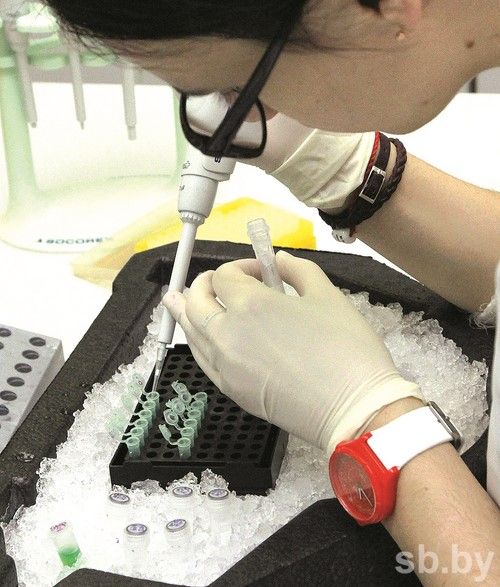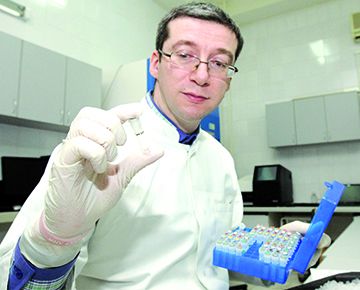Leukaemia is found each year in 60-80 young people and nearly 240 adults in our country. The efficiency in curing it in many respects depends on how quickly and precisely diagnosis is carried out. Experts are constantly striving to try to improve their methods. One new example of this is the Laboratory of Genetic Biotechnology at the Republican Scientific and Practical Centre for Paediatric Oncology, Haematology and Immunology, where a test-system for the diagnosis of genetic abnormalities among children with acute leukaemia has been developed. Within a very short period of time it will allow us to not only understand what kind of blood cancer a patient is suffering from, but also to define the best approach for treatment. The work has been recognised as the best in its category at the Republican contest of innovative projects.

Anatoly Kustanovich and the development-winner
Genetic changes in cells lead to leukaemia. If these can be identified at an early stage, we can gain valuable information from them, for example, as to what medication the illness is most susceptible. The disease which once was called ‘blood cancer’ is now subdivided into approximately 70 categories, of these, approximately eighteen subgroups are acute leukaemias. The test-system allows doctors to study up to 20 genes, important for diagnosing and understanding the disease.
“First, it helps to make diagnosis precise and to choose the optimum therapy depending on the type of acute leukaemia. Secondly, there is a possibility of using targeted medications based on the genetic changes revealed by the tests. Thirdly, such diagnostics are important for assessing the efficiency of treatment and tracking the remaining cancerous cells. As we know, genetic change is the characteristic of these cells, for us it is a disease marker. If during subsequent analyses there are no changed cells, it means in all probability the patient is in remission and additionally, their presence will help to define and prevent the return of the disease,” Anatoly Kustanovich, Head of the Laboratory of Genetic Biotechnology discusses the possibilities of the method.

Anatoly Kustanovich and the development-winner
Initially, the Republican Scientific and Practical Centre was developing its own test-system to make diagnosis more effective, to find a convenient method which would be used by a small team of analysts and would allow doctors to receive the information quickly. As a result, now it takes just a day: if the cell material of patients with leukaemia arrives at the laboratory in the morning, then the result could be ready by the evening. Anatoly Kustanovich confirms it is only a part of the diagnostic process and the choice of therapy is not based only on this test; a range of other measures are also carried out. In addition, the test-system is flexible and can be adapted to solve different problems, for example, by increasing the number of defined genes.
Thanks to this latest development, a further advantage is that it will allow import substitution, a constant goal of the government. The Republican Republican Scientific and Practical Centre has recently considered using the Danish company HemaVision for the study of acute leukaemia; however, it was necessary to refuse the contract because of difficulties with the purchases and the high cost of analysis, at 100 Euros per person. The cost price of similar research using our own test-system is 10 times less. The new method is now at the patenting stage. The benefits from it will not only be economic, but also social: one more ally in the struggle against this devastating illness is welcomed.
By Yulia Vasilishina











